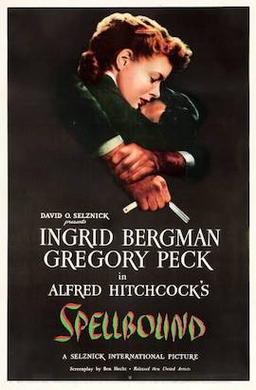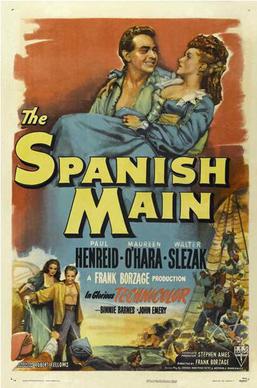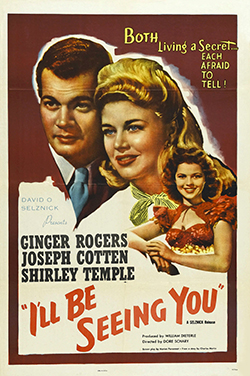
Joseph Cheshire Cotten Jr. was an American film, stage, radio and television actor. Cotten achieved prominence on Broadway, starring in the original stage productions of The Philadelphia Story and Sabrina Fair. He then gained worldwide fame in three Orson Welles films: Citizen Kane (1941), The Magnificent Ambersons (1942), and Journey into Fear (1943), for which Cotten was also credited with the screenplay.

Ingrid Bergman was a Swedish actress who starred in a variety of European and American films, television movies, and plays. With a career spanning five decades, she is often regarded as one of the most influential screen figures in cinematic history.

David O. Selznick was an American film producer, screenwriter and film studio executive who produced Gone with the Wind (1939) and Rebecca (1940), both of which earned him an Academy Award for Best Picture.

Spellbound is a 1945 American psychological thriller film directed by Alfred Hitchcock, and starring Ingrid Bergman, Gregory Peck, and Michael Chekhov. It follows a psychoanalyst who falls in love with the new head of the Vermont hospital in which she works, only to find that he is an imposter suffering dissociative amnesia, and potentially, a murderer. The film is based on the 1927 novel The House of Dr. Edwardes by Hilary Saint George Saunders and John Palmer.

Dorothy Hackett McGuire was an American actress. She was nominated for the Academy Award for Best Actress for Gentleman's Agreement (1947) and won the National Board of Review Award for Best Actress for Friendly Persuasion (1956). She starred as the eponymous mother in the popular film Swiss Family Robinson (1960).

Notorious is a 1946 American spy film noir directed and produced by Alfred Hitchcock, starring Cary Grant, Ingrid Bergman, and Claude Rains as three people whose lives become intimately entangled during an espionage operation.

The Paradine Case is a 1947 American film noir courtroom drama film, set in England, directed by Alfred Hitchcock and produced by David O. Selznick. The screenplay was written by Selznick and an uncredited Ben Hecht, from an adaptation by Alma Reville and James Bridie of the 1933 novel of the same title by Robert Smythe Hichens. The film stars Gregory Peck, Ann Todd, Alida Valli, Charles Laughton, Charles Coburn, Ethel Barrymore, and Louis Jourdan. It tells of an English barrister who falls in love with a woman who is accused of murder, and how it affects his relationship with his wife.
Isadore "Dore" Schary was an American playwright, director, and producer for the stage and a prolific screenwriter and producer of motion pictures. He directed just one feature film, Act One, the film biography of his friend, playwright and theater director Moss Hart. He became head of production at Metro-Goldwyn-Mayer and replaced Louis B. Mayer as president of the studio in 1951.

Rebecca is a 1940 American romantic psychological thriller film directed by Alfred Hitchcock. It was Hitchcock's first American project, and his first film under contract with producer David O. Selznick. The screenplay by Robert E. Sherwood and Joan Harrison, and adaptation by Philip MacDonald and Michael Hogan, were based on the 1938 novel of the same name by Daphne du Maurier.

Val Lewton was a Russian-American novelist, film producer and screenwriter best known for a string of low-budget horror films he produced for RKO Pictures in the 1940s. His son, also named Val Lewton, was a painter and exhibition designer.

Selznick International Pictures was a Hollywood motion picture studio created by David O. Selznick in 1935, and dissolved in 1943. In its short existence the independent studio produced two films that received the Academy Award for Best Picture—Gone with the Wind (1939) and Rebecca (1940)—and three that were nominated, A Star Is Born (1937), Since You Went Away (1944) and Spellbound (1945).

The Spanish Main is a 1945 American adventure film starring Paul Henreid, Maureen O'Hara, Walter Slezak and Binnie Barnes, and directed by Frank Borzage. It was RKO's first all-Technicolor film since Becky Sharp ten years before.
Charles Schnee was a screenwriter and film producer. He wrote the scripts for the Westerns Red River (1948) and The Furies (1950), the social melodrama They Live by Night (1949), and the cynical Hollywood saga The Bad and the Beautiful (1952), for which he won an Academy Award.

I'll Be Seeing You is a 1944 American drama film made by Selznick International Pictures, Dore Schary Productions, and Vanguard Pictures, and distributed by United Artists. It stars Joseph Cotten, Ginger Rogers, and Shirley Temple, with Spring Byington, Tom Tully, and John Derek. It was produced by Dore Schary, with David O. Selznick as executive producer. The screenplay was by Marion Parsonnet, based on a radio play by Charles Martin (1910-1983).

The Culver Studios is a movie studio in Culver City, California. Originally created by silent movie pioneer Thomas H. Ince, classics from Hollywood's Golden Age were filmed there. It is currently owned by Hackman Capital Partners, which completely modernized the lot — more than doubling its size — for next-generation entertainment, while preserving the site's historic structures. The studios have operated under a multitude of names: Ince Studio (1918-1925), De Mille Studios (1925–1928), Pathé Studios (1928–1931), RKO-Pathé Studios (1931–1935), Selznick International Pictures (1935–1956), Desilu-Culver Studios (1956–1970), Culver City Studios (1970–1977), and Laird International Studios (1977–1986). Through all these name changes, the site was also commonly called "40 Acres" by entertainment industry insiders, although it was never actually 40 acres in size.

James Graham Stewart was an American pioneer in the field of sound recording and re-recording. His career spanned more than five decades (1928–1980), during which he made substantial contributions to the evolution of the art and science of film and television sound.

David O. Selznick (1902–1965) was an American motion picture producer whose work consists of three short subjects, 67 feature films, and one television production made between 1923 and 1957. He was the producer of the 1939 epic Gone With the Wind. Selznick was born in Pittsburgh and educated in public schools in Brooklyn and Manhattan. He began working in the film industry in New York while in his teens as an assistant to his father, jeweler-turned-film producer Lewis J. Selznick. In 1923, he began producing films himself, starting with two documentary shorts and then a minor feature, Roulette (1924). Moving to Hollywood in 1926, Selznick became employed at Metro-Goldwyn-Mayer (MGM), where he produced two films before switching to Paramount in early 1928. After helping to guide Paramount into the sound era, Selznick moved to RKO Radio in 1931 where he served as the studio's executive producer. During his time at RKO he oversaw the production of King Kong (1933) and helped to develop Katharine Hepburn and Myrna Loy into major film stars.

RKO Radio Pictures Inc., commonly known as RKO Pictures or simply RKO, was an American film production and distribution company, one of the "Big Five" film studios of Hollywood's Golden Age. The business was formed after the Keith-Albee-Orpheum (KAO) theater chain and Joseph P. Kennedy's Film Booking Offices of America (FBO) studio were brought together under the control of the Radio Corporation of America (RCA) in October 1928. RCA chief David Sarnoff engineered the merger to create a market for the company's sound-on-film technology, RCA Photophone, and in early 1929 production began under the RKO name. Two years later, another Kennedy holding, the Pathé studio, was folded into the operation. By the mid-1940s, RKO was controlled by investor Floyd Odlum.
Charles Koerner was an American film executive, best known for being executive vice president over production at RKO Pictures from 1942 to 1946.
Samuel Donald Hartman was an American screenwriter and director and former production head of Paramount Pictures. He and Stephen Morehouse Avery were nominated for the Academy Award for Best Story for The Gay Deception (1935). He was also nominated with Frank Butler for the Academy Award for Best Original Screenplay for Road to Morocco in 1942.
















